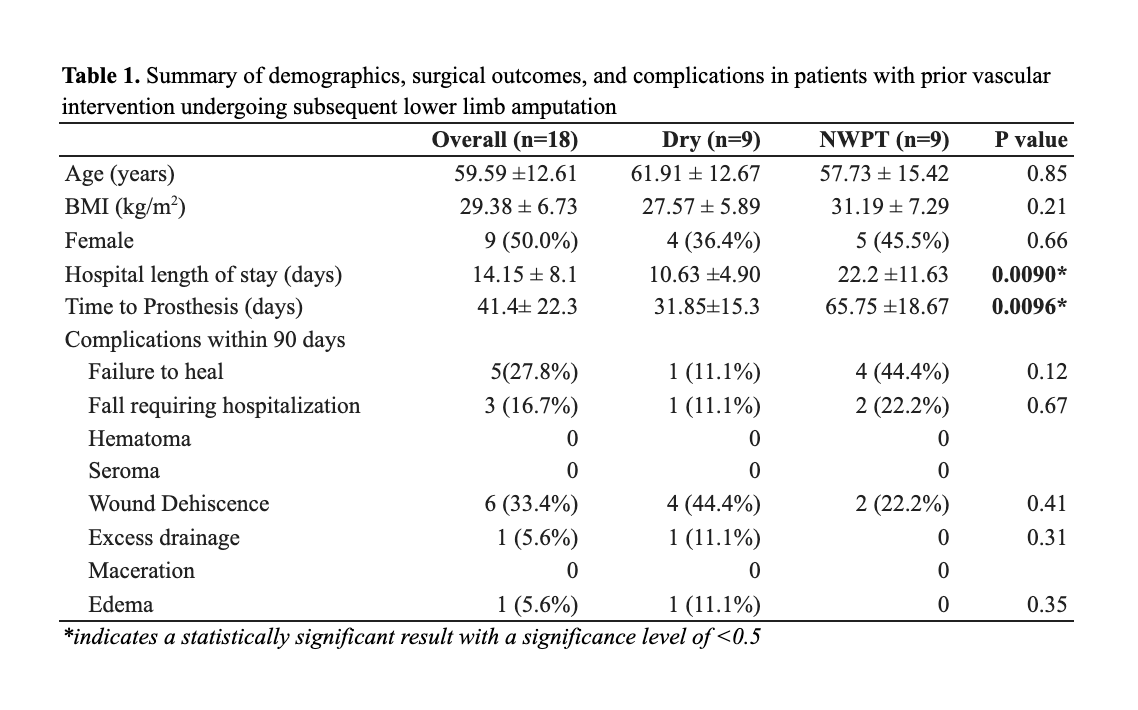Negative Pressure Wound Therapy for At-Risk Lower Limb Amputation Surgical Closures in Patients With Prior Vascular Intervention: A Randomized Control Study
Holly D Shan1, Charli A Pogany1, Firras S Garada2, Samuel S Huffman1, Christopher E Attinger3
1Georgetown University School of Medicine, Washington DC, DC;2Fellow, Medstar Georgetown University Hospital, Washington DC, DC;3Attending, Georgetown Medstar University Hospital, Washington DC, DC
Background: Reconstructive vascular surgery and invasive interventions often fails and leads to increased incidence of aggressive lower limb amputations. Due to the complexity of patients who undergo vascular surgery, additional considerations must be made for wound healing following lower limb amputation. However, there is no consensus on post-operative care for these patients. The purpose of this study is to evaluate the effect of Negative Pressure Wound Therapy (NPWT) on closed surgical incisions in vascular patients who underwent subsequent lower limb amputation.
Methods: We performed a prospective randomized controlled clinical trial from 2018-2021 comparing NPWT to standard dry dressings on lower limb amputation surgical incisions in patients with prior vascular interventions. Vascular interventions included endovascular surgery, open bypass, balloon angioplasty, and angioplasty stent placement. Patients presenting to a high-volume wound center were randomized to receive either NPWT or a standard dry dressing over their incision at the conclusion of surgery. The two groups were compared, and all incisions were evaluated for infection and dehiscence 90 days postoperatively.
Results: Of the 18 patients identified (59.59 ±12.61 years, 29.38 ± 6.73 kg/m2 BMI), 14 underwent a BKA, 4 underwent an AKA, and there were 27 vascular interventions (13 endovascular surgeries, 2 open bypass, 9 balloon angioplasty, 3 angioplasty stents). There were no differences in rates of complications 90 days after lower limb amputation in failure to heal, fall requiring hospitalization, hematomas, seromas, wound dehiscence, excess drainage, maceration, or edema (Table 1). Patients who had a standard dry dressing had a shorter length of stay (10.63±4.90 days) compared to the NPWT group (22.2±11.6 days) (p=0.0090). The dry dressing cohort waited less time to use their prosthesis (31.85±15.3 days) compared to the NWPT cohort (65.75±18.67 days) (p=0.0096).
Conclusion: We found similar rates of postoperative complications within the dry and NWPT cohorts. Those who received NWPT on their closed incision had twice as long of a hospital stay and waited twice as long to use their prosthetic successfully. Patients with prior vascular interventions undergoing lower limb amputation should be advised of possible prolonged recovery time based on wound healing technique.

Back to 2023 Display Posters


